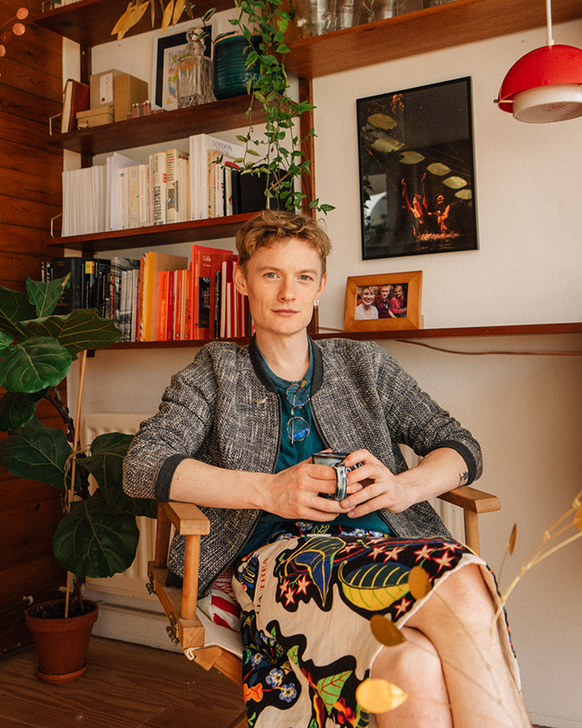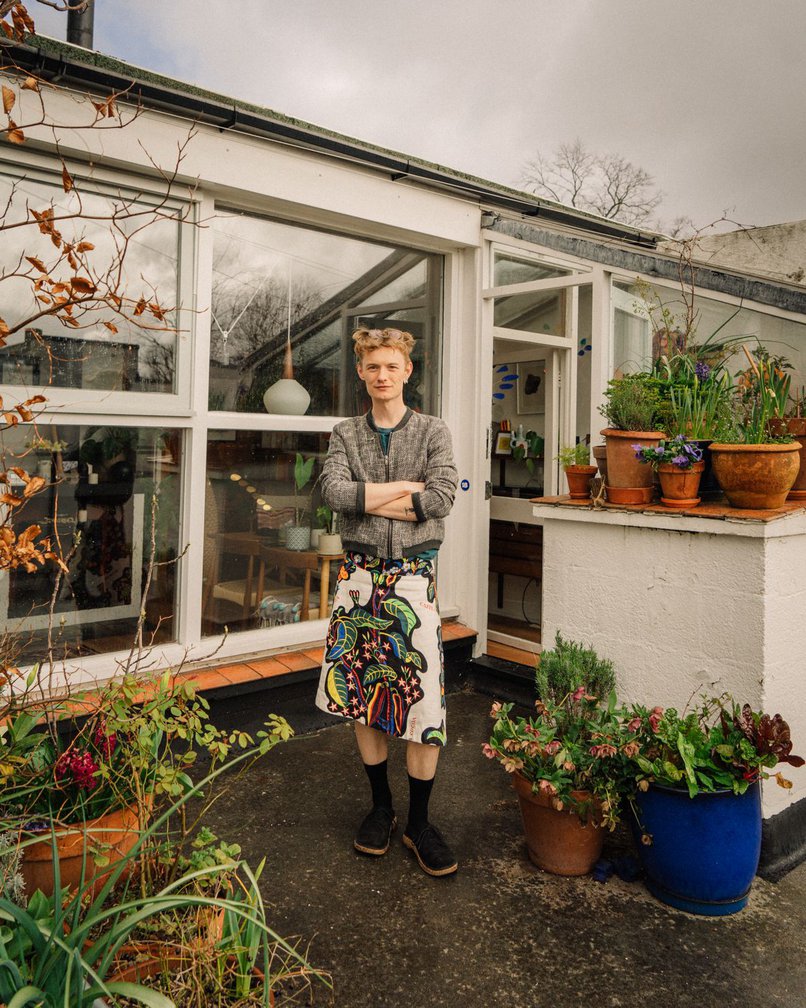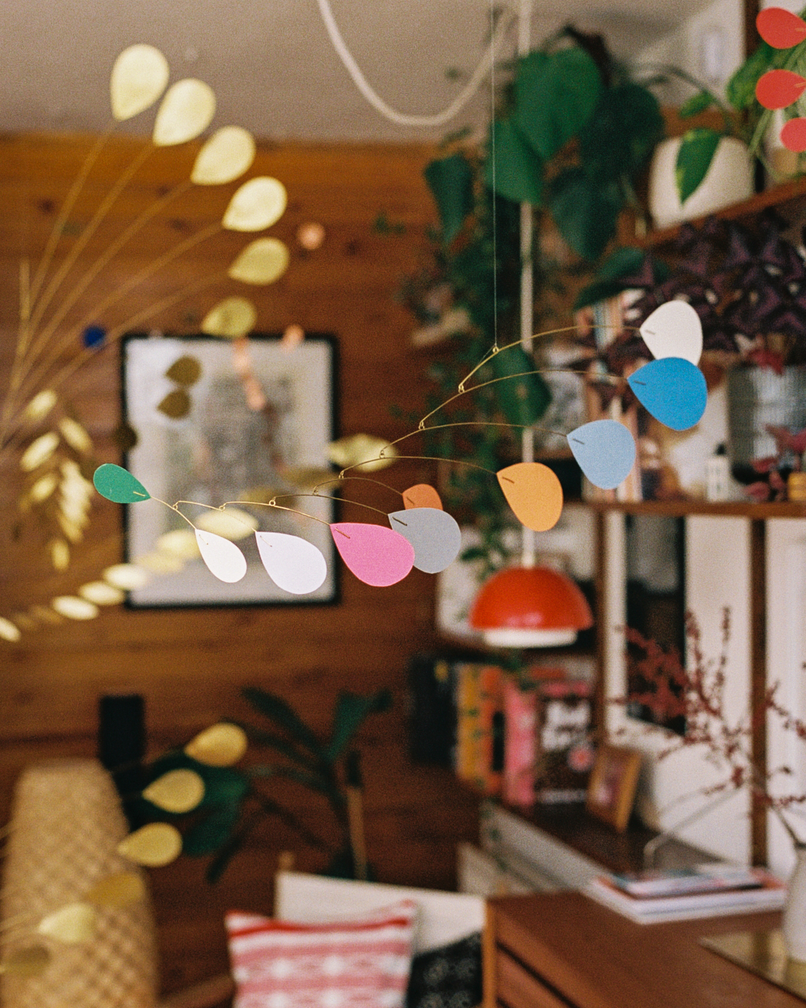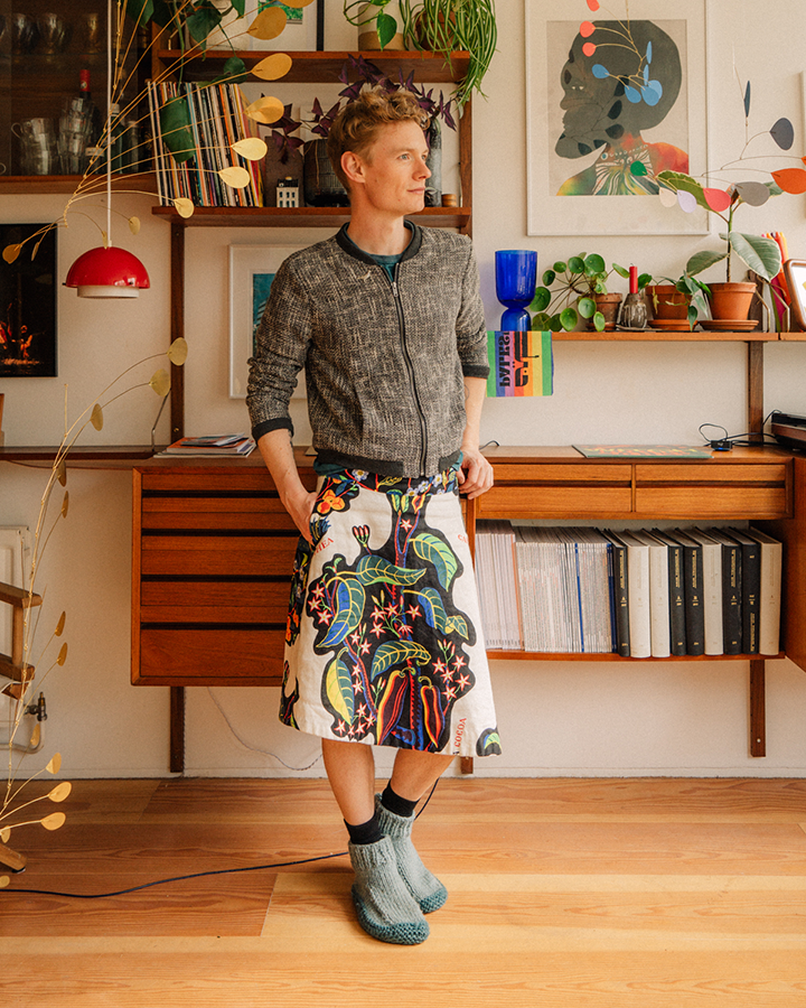article In conversation with Phineas Harper
In conversation with Phineas Harper

In conversation with Phineas Harper
about whimsy, architectural structures
and the modernist mantra of Ray Eames
about whimsy, architectural structures
and the modernist mantra of Ray Eames
In conversation with Phineas Harper
about whimsy, architectural structures
and the modernist mantra of Ray Eames

Phineas Harper develops sustainable cultural programmes that engage broad audiences with architecture and design. A regular contributor to The Guardian and a columnist at Dezeen, their career spans criticism, curation, education, youth engagement, journalism and sculpture.

Artiq Can you share what initially sparked your interest in making mobiles?
Phineas I find some corners of the art world a little stuffy. There’s a whiff of snobbery sometimes associated with kinetic art, and mobiles in particular – too childish, too whimsical. I find this attitude rather silly. Art, of course, can wrestle with complex politics and heavy themes but it can also be joyful, gregarious and fun. My first mobile was made simply to evoke the feeling of flowers blooming in a vase or a crab apple tree swaying in the breeze – gently lifting the spirit even on a gloomy day.
Artiq You write, curate and also have a background in architecture. In what ways do these areas inform your current art practice?
Phineas My pieces are hugely structural. They are each intricate games of balance and material properties as much as they are compositions. I sometimes wonder what the mathematical model of each mobile’s structural system would be like, but try to stop before I get a headache! I also see mobiles as inherently architectural because so much of their character relates to the space they are in. A painting is a painting but open a window in my flat and every mobile suddenly takes on a new personality.
Phineas I find some corners of the art world a little stuffy. There’s a whiff of snobbery sometimes associated with kinetic art, and mobiles in particular – too childish, too whimsical. I find this attitude rather silly. Art, of course, can wrestle with complex politics and heavy themes but it can also be joyful, gregarious and fun. My first mobile was made simply to evoke the feeling of flowers blooming in a vase or a crab apple tree swaying in the breeze – gently lifting the spirit even on a gloomy day.
Artiq You write, curate and also have a background in architecture. In what ways do these areas inform your current art practice?
Phineas My pieces are hugely structural. They are each intricate games of balance and material properties as much as they are compositions. I sometimes wonder what the mathematical model of each mobile’s structural system would be like, but try to stop before I get a headache! I also see mobiles as inherently architectural because so much of their character relates to the space they are in. A painting is a painting but open a window in my flat and every mobile suddenly takes on a new personality.

Artiq Your pieces are intricately made and can take multiple days to finish. In a world which frequently centres around mass production, can you discuss the value of hand-crafted objects?
Phineas I’m a huge fan of mass production. The Modernist mantra of Ray Eames, “The best for the most for the least” is absolutely right in calling for the fruits of industry to be shared with as many people as possible. At the same time, it is clear that globalised mass production alone does not guarantee a good and meaningful life – we need the synthesis of both scales; intimacy and society.
Think about sex. Sex without deeply personal intimacy is, for me at least, extremely unappealing but would you want to use an “artisanal hand-made condom” or a “small batch locally-produced contraceptive pill”? Possibly not! It’s hard to think of anything further from the logic of a corporate production line than sleeping with someone you love, but the market cap of Durex’s parent company is over £30 billion. Ultimately hand made and mass made can be good bedfellows after all. My mobiles are all unique compositions but I use mass-produced industrial materials like sheet metal, wire and veneer to create them and play with this contradiction.
Artiq You wrote a piece for the Artiq Annual Volume Two about art which ‘goes against the grain of capitalism and commodification’. How do these ideas relate to your personal art practice?
Phineas My work is not as clever in the games it plays with the economics of the contemporary art market as the pieces I wrote about in my essay of the Artiq annual. Nonetheless I’m intrigued by how art inherently questions our definitions of value. Karl Marx thought that an object or product’s value should simply be the value of the labour that went into producing it. But artworks, obviously, are routinely bought and sold for far more (or far less) than the cost of the labour it took to make them.
Phineas I’m a huge fan of mass production. The Modernist mantra of Ray Eames, “The best for the most for the least” is absolutely right in calling for the fruits of industry to be shared with as many people as possible. At the same time, it is clear that globalised mass production alone does not guarantee a good and meaningful life – we need the synthesis of both scales; intimacy and society.
Think about sex. Sex without deeply personal intimacy is, for me at least, extremely unappealing but would you want to use an “artisanal hand-made condom” or a “small batch locally-produced contraceptive pill”? Possibly not! It’s hard to think of anything further from the logic of a corporate production line than sleeping with someone you love, but the market cap of Durex’s parent company is over £30 billion. Ultimately hand made and mass made can be good bedfellows after all. My mobiles are all unique compositions but I use mass-produced industrial materials like sheet metal, wire and veneer to create them and play with this contradiction.
Artiq You wrote a piece for the Artiq Annual Volume Two about art which ‘goes against the grain of capitalism and commodification’. How do these ideas relate to your personal art practice?
Phineas My work is not as clever in the games it plays with the economics of the contemporary art market as the pieces I wrote about in my essay of the Artiq annual. Nonetheless I’m intrigued by how art inherently questions our definitions of value. Karl Marx thought that an object or product’s value should simply be the value of the labour that went into producing it. But artworks, obviously, are routinely bought and sold for far more (or far less) than the cost of the labour it took to make them.

Artiq From your experience, how can art be used as a tool to engage local communities and foster deeper social impact, particularly amongst young people?
Phineas In architecture we have a bad habit of thinking that the best and most meaningful way to engage young people with the urban landscape is through art. It’s this assumption which leads property developers to plaster children’s drawings on the hoardings of construction sites, or invite teenagers to paint murals on designated walls. I’ve nothing against murals, but I can’t help thinking these engagement tactics are ultimately about quarantining young people’s impact on architecture to the most narrow and shallow outcome possible. Far better would be a culture of meaningful, holistic and long-term youth engagement which took children’s voices as seriously as, say, retirees in weighing up major developments. Give kids paint brushes and a wall to draw on by all means, but give them votes too.
Artiq Having worked with Artiq on a commission for London School of Economics, can you discuss the contrast between making and displaying work in public vs private spaces?
Phineas For me scale was the biggest difference. My private pieces have mostly been domestic in scale – the perfect size to catch rays of light in the corner of a living room or dangle above a stairwell. LSE’s Marshall Building by Grafton Architects is colossal with a vast neo-Brutalist atrium and floors of generous communal space. I made the mobile in France while staying at a dilapidated but beautiful former chestnut farm and brought it back to London in huge pieces by train. The Eurostar security guards were rather confused!
Phineas In architecture we have a bad habit of thinking that the best and most meaningful way to engage young people with the urban landscape is through art. It’s this assumption which leads property developers to plaster children’s drawings on the hoardings of construction sites, or invite teenagers to paint murals on designated walls. I’ve nothing against murals, but I can’t help thinking these engagement tactics are ultimately about quarantining young people’s impact on architecture to the most narrow and shallow outcome possible. Far better would be a culture of meaningful, holistic and long-term youth engagement which took children’s voices as seriously as, say, retirees in weighing up major developments. Give kids paint brushes and a wall to draw on by all means, but give them votes too.
Artiq Having worked with Artiq on a commission for London School of Economics, can you discuss the contrast between making and displaying work in public vs private spaces?
Phineas For me scale was the biggest difference. My private pieces have mostly been domestic in scale – the perfect size to catch rays of light in the corner of a living room or dangle above a stairwell. LSE’s Marshall Building by Grafton Architects is colossal with a vast neo-Brutalist atrium and floors of generous communal space. I made the mobile in France while staying at a dilapidated but beautiful former chestnut farm and brought it back to London in huge pieces by train. The Eurostar security guards were rather confused!

Artiq As we touched upon during our visit, a distinction is often made between the fields of ‘art’ and ‘craft’. How do you respond to this? Do you see this perception shifting in the future?
Phineas I was once called as an expert witness to a planning inquiry which centred on a work of new architecture on the roof of a warehouse in Hoxton. The owner of the warehouse argued that, because he had been displaying art in the form of large-scale sculptures on the roof for over ten years, he had immunity from needing planning permission for the new architecture. But Hackney Council’s lawyers argued that architecture is fundamentally different to art so the immunity was void. My job was to define the difference between architecture and art – I couldn’t do it.
Academics will endlessly debate the definition of art. Is architecture art? Is craft art? Is weaving art? Are forensic investigations of war crimes art? I understand why they do it but it’s just not so interesting to me. I think the best curators are the ones who aren’t tangled up in knots about definitions but are making shows and commissions that simply speak to people by any means necessary.
Artiq In what ways do you see your practice developing over the next year? Do you have any upcoming projects or exhibitions that you would like to share with us?
Phineas I am currently working on an installation at San Mei Gallery in Brixton and a contribution to the Rotterdam Biennale but I’d love to take on more commissions this year, particularly larger pieces. People who’ve bought my mobiles in the past tell me they bring them joy and calm – I reckon we could all do with more of both those things this year.
Phineas I was once called as an expert witness to a planning inquiry which centred on a work of new architecture on the roof of a warehouse in Hoxton. The owner of the warehouse argued that, because he had been displaying art in the form of large-scale sculptures on the roof for over ten years, he had immunity from needing planning permission for the new architecture. But Hackney Council’s lawyers argued that architecture is fundamentally different to art so the immunity was void. My job was to define the difference between architecture and art – I couldn’t do it.
Academics will endlessly debate the definition of art. Is architecture art? Is craft art? Is weaving art? Are forensic investigations of war crimes art? I understand why they do it but it’s just not so interesting to me. I think the best curators are the ones who aren’t tangled up in knots about definitions but are making shows and commissions that simply speak to people by any means necessary.
Artiq In what ways do you see your practice developing over the next year? Do you have any upcoming projects or exhibitions that you would like to share with us?
Phineas I am currently working on an installation at San Mei Gallery in Brixton and a contribution to the Rotterdam Biennale but I’d love to take on more commissions this year, particularly larger pieces. People who’ve bought my mobiles in the past tell me they bring them joy and calm – I reckon we could all do with more of both those things this year.